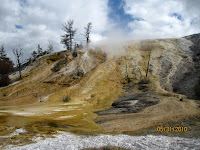2. Our plan for the 2nd day at Yellowstone (May 30, Day 13) was to continue our exploration by taking the upper loop of the figure-of-8, starting from Madison to Mammoth Hot Springs in the North, traveling along the Northern route and down the Eastern loop , before returning to West Yellowstone.
3. We started the day at about 10 am. It was a chilly day. We made 3 stops to see more geysers, hot springs, steam vents and mud pots. They were:
(a) Artist Paint Pots, for its colours; varying shades of blue, gray, yellow and brown; their colours depending on the type of mineral deposits and the texture on the amount subterranean water.



(b) Norris Geyser Basin -2.5 mile trail that include the world's tallest active geyser, Steamboat Geyser, which could shoot to height of 300 ft (trouble was you never know when it's going to erupt) and the Norris Museum.

 Video shows Arch Steam Vent.
Video shows Arch Steam Vent.(c) Mammoth Hot Springs - The many tiers of limestone slopes where hot water seeped through the network of fractures and fissures and flowed down the rock surfaces, creating interesting textures and colours. Pictures here show Palette Spring. Near Palette Spring was this unusual rock formation called Liberty Cap.



Unfortunately, many of the upper tiers have become largely "extinct" (maybe that's why this is called Mammoth Hot Springs, we were jokingly saying), as water was no longer flowing, possibly because the underground plumbing network was altered by volcanic activities.


 4. Along the Northern loop, we made a detour to see a 50 mil years petrified tree. We were unimpressed though I am sure its a treasure to geologists and scientists. This explained why it was fenced up as it had been vandalised before.
4. Along the Northern loop, we made a detour to see a 50 mil years petrified tree. We were unimpressed though I am sure its a treasure to geologists and scientists. This explained why it was fenced up as it had been vandalised before.5. Along the same route, we were fortunate to catch an elk grazing next to the road. First time we saw one at such close range.

6. A few miles South of Tower Junction was the 132 ft Tower Fall. We took a short walk to see this magnificent waterfall. There was a path that allowed visitors to descend to the
 bottom of the fall but we had little energy to climb back to the top. It's been a long day.
bottom of the fall but we had little energy to climb back to the top. It's been a long day.
7. Traveling Westward from Canyon Village to Madison, on the way back to West Yellowstone, we were pleasantly surprised to see ground of the forested areas still covered with snow and we were approaching June. But, we shouldn't be surprised as Yellowstone is generally located between 7000-9000 ft.

No comments:
Post a Comment